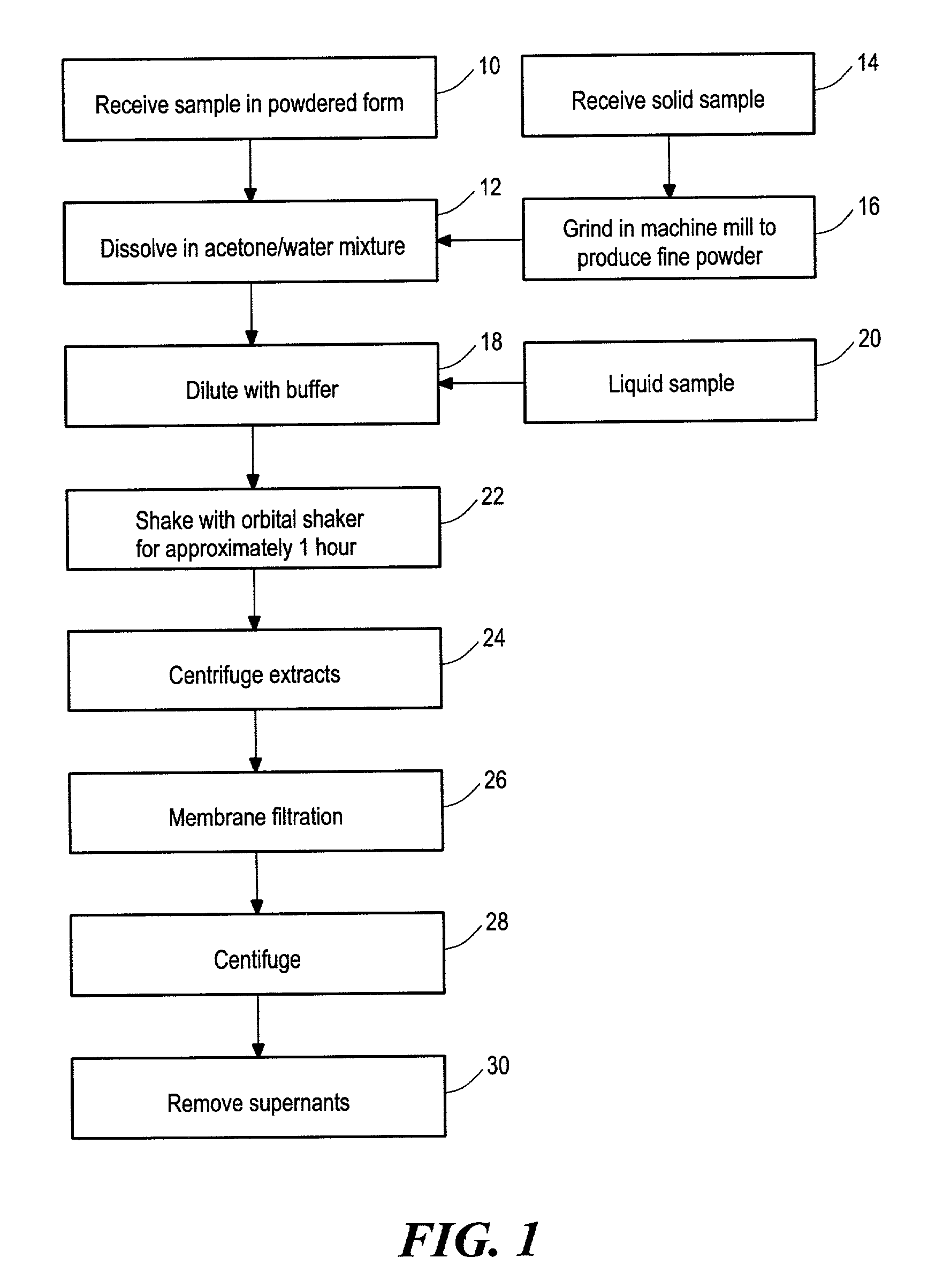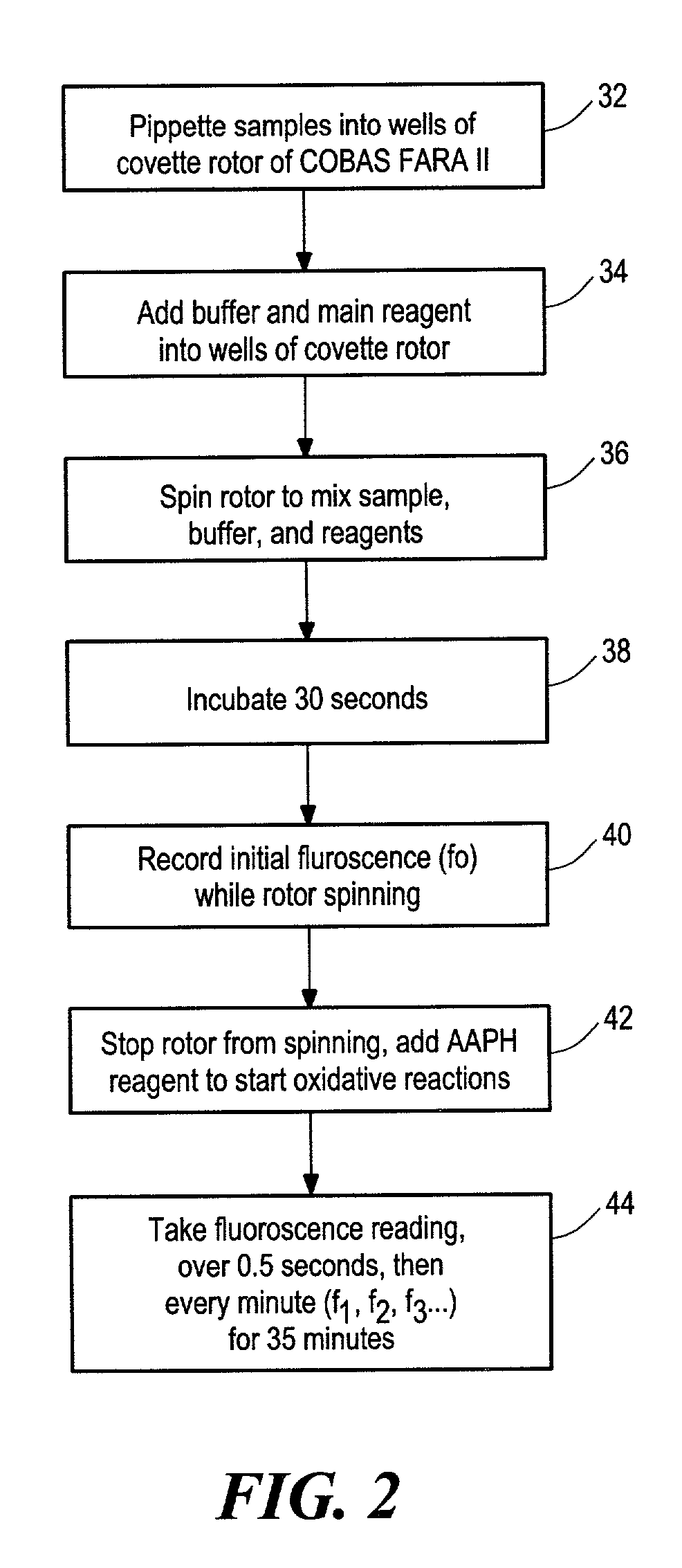Method for assaying the antioxidant capacity of a sample
- Summary
- Abstract
- Description
- Claims
- Application Information
AI Technical Summary
Benefits of technology
Problems solved by technology
Method used
Image
Examples
example 1
Materials and Methods
[0098]Flavonoid compounds and β-phycoerythrin were purchased from Sigma (St. Louis, Mo.). Trolox, ascorbic acid and disodium fluorescein were obtained from Aldrich (Milwaukee, Wis.). 2,2′-azobis (2-amidino-propane) dihydrochloride (AAPH) was purchased from Wako Chemicals USA (Richmond, Va.). Various analyzed samples were also obtained. ORAC analyses were performed on a COBAS FARA II analyzer (Roche Diagnostic System Inc., Branchburg, N.J.; Excitation wavelength=493 nm and emission filter=515 nm).
[0099]Ascorbic acid and flavonoids were directly dissolved in acetone / water mixture (50:50, v / v) and diluted with pH 7.4 phosphate buffer for analysis. The solid samples were initially ground in a mechanical mill to produce a fine power; then 0.5 grams were accurately weighed and 20 mL of acetone / water (50:50, v / v) extraction solvent was added. The mixture was shaken at 400 RPM at room temperature on an orbital shaker for one hour. The extracts were centrifuged at 14000 ...
example 2
Modified Assay for Lipophilic Antioxidants Using Solubility Enhancing Randomly Methylated Cyclodextrin
[0101]Chemicals and Apparatus. Cyclodextrin derivatives were supplied from Cyclodextrin Technologies Development, Inc. (Gainesville, Fla.). Fluorescein (FL) and Trolox were purchased from Aldrich (Milwaukee, Wis.). 2,2′-azobis (2-amidino-propane) dihydrochloride (AAPH) was obtained from Wako Chemicals USA (Richmond, Va.). γ-Oryzanol was purchased from TCI America (Portland, Oreg.); nutriene (tocotrienols) was obtained from Eastman Chemicals Company (Kingsport, Tenn.). All other standards were commercially available form Sigma or Aldrich. Analyses were performed on a COBAS FARA II analyzer (Roche Diagnostic System Inc., Branchburg, N.J. using an excitation wavelength of 493 nm and an emission filter of 515 nm or alternatively, the sample may be analyzed with a FL600 microplate fluorescence reader (Bio-Tek Instruments, Inc., Winooski, Vt.) with fluorescence filters for an excitation w...
example 3
Using a Plurality of Standards
[0107]Trolox concentrations of 20, 40, 75 μM were used as QC samples. Samples and Trolox calibration solutions were always analyzed in duplicate in a “forward-then-reverse” order as follows: blank, 12.5 μM Trolox, 25 μM Trolox, 50 μM Trolox, 100 μM Trolox, QC, sample 1 . . . sample 1, QC, 100 μM, 50 μM, 25 μM, 12.5 μM, blank. This arrangement can correct for possible errors due to the signal drifting associated with the different positions of the same sample. Nine samples can be tested in duplicate in each analysis. The final ORAC values are calculated by using a regression equation between the Trolox concentration and the net area under the FL decay curve and are expressed as Trolox equivalents as micromole per liter or per gram. The area under curve (AUC) is calculated as shown above in equations (1) and (2).
[0108]Characterization of Fluerescein (FL) oxidized products. FL (4.38×10−7 M) was incubated at 37° C. for 20 min with AAPH (1.28×10−2 M) at pH 7...
PUM
 Login to View More
Login to View More Abstract
Description
Claims
Application Information
 Login to View More
Login to View More - R&D
- Intellectual Property
- Life Sciences
- Materials
- Tech Scout
- Unparalleled Data Quality
- Higher Quality Content
- 60% Fewer Hallucinations
Browse by: Latest US Patents, China's latest patents, Technical Efficacy Thesaurus, Application Domain, Technology Topic, Popular Technical Reports.
© 2025 PatSnap. All rights reserved.Legal|Privacy policy|Modern Slavery Act Transparency Statement|Sitemap|About US| Contact US: help@patsnap.com



